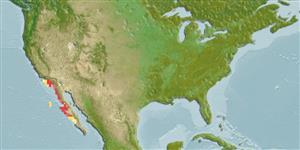Environment: milieu / climate zone / depth range / distribution range
Ecología
marino; salobre; rango de profundidad 0 - 50 m (Ref. 189). Subtropical; 34°N - 20°N, 120°W - 109°W (Ref. 189)
Eastern Central Pacific: Belmont Shores, Long Beach Harbor, California, USA south to Magdalena Bay on the Pacific coast of Baja California; not in Gulf of California.
Tamaño / Peso / Age
Maturity: Lm ? range ? - ? cm
Max length : 12.0 cm TL macho / no sexado; (Ref. 96339); common length : 7.0 cm SL macho / no sexado; (Ref. 9298); edad máxima reportada: 3.00 años (Ref. 72482)
Short description
Claves de identificación | Morfología | Morfometría
Espinas dorsales (total) : 0; Espinas anales: 0; Radios blandos anales: 20 - 25. Body fairly elongate. Snout moderate, about 3/4 eye diameter; maxilla moderate, tip pointed, reaching onto inter-operculum, but not to edge of gill cover; gill cover canals of walkeri-type. Anal fin moderate, its origin usually somewhat before midpoint of dorsal fin base. A silver stripe along flank, about 3/4 eye diameter.
Reportedly common in estuaries and backwaters of bays and occasionally near shores outside bays (Ref. 6792). The fifth most abundant fish taken by various gear in Newport Bay, California; a midwater schooling species caught in bag seine hauls mainly in July and September (Ref. 6361). Oviparous, with planktonic eggs and larvae (Ref. 35602).
Life cycle and mating behavior
Maturities | Reproducción | Spawnings | Egg(s) | Fecundities | Larva
Oviparous (Ref. 35602). Spawn in school (Ref. 205).
Whitehead, P.J.P., G.J. Nelson and T. Wongratana, 1988. FAO Species Catalogue. Vol. 7. Clupeoid fishes of the world (Suborder Clupeoidei). An annotated and illustrated catalogue of the herrings, sardines, pilchards, sprats, shads, anchovies and wolf-herrings. FAO Fish. Synop. 125(7/2):305-579. Rome: FAO. (Ref. 189)
IUCN Red List Status (Ref. 130435)
Threat to humans
Harmless
Human uses
Pesquerías: pesquerías de subsistencia
Herramientas
Special reports
Download XML
Fuentes de Internet
Estimates based on models
Preferred temperature (Ref.
123201): 17.4 - 18.1, mean 17.7 °C (based on 2 cells).
Phylogenetic diversity index (Ref.
82804): PD
50 = 0.5000 [Uniqueness, from 0.5 = low to 2.0 = high].
Bayesian length-weight: a=0.00513 (0.00232 - 0.01135), b=3.14 (2.96 - 3.32), in cm total length, based on LWR estimates for this Genus-body shape (Ref.
93245).
Nivel trófico (Ref.
69278): 3.4 ±0.4 se; based on size and trophs of closest relatives
Resiliencia (Ref.
120179): Alto, población duplicada en un tiempo mínimo inferior a 15 meses (tmax=3).
Fishing Vulnerability (Ref.
59153): Low vulnerability (10 of 100).
